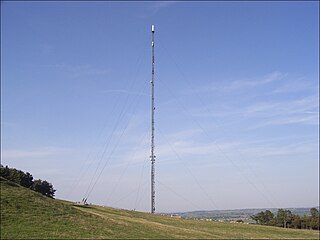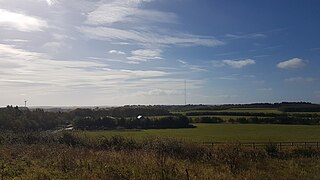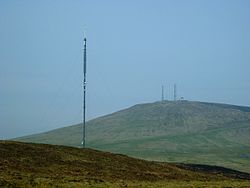
The Bilsdale transmitting station is a broadcasting and telecommunications facility, located at Bilsdale West Moor above Bilsdale, close to Helmsley, North Yorkshire, England. The original facility included a guyed steel tubular mast that was primarily used for radio and television transmission. The height of the mast was 314 metres (1,030 ft) to the pinnacle. Until a fire disabled the transmitter on 10 August 2021 it was among the most powerful transmitters in the UK. The power for analogue was 500 kW ERP and it was 100 kW / 50 kW for digital. The mast was equipped with aircraft warning lights, in the form of arrays of red LEDs. The station was owned and operated by Arqiva. After the main mast was disabled a temporary 80 metres (260 ft) mast was installed at the site. The temporary mast commenced operations on 13 October 2021.

The Pontop Pike transmitting station is a facility for telecommunications and broadcasting situated on a 312-metre (1,024-ft) high hill of the same name between Stanley and Consett, County Durham, near the village of Dipton, England. The mast is 149 metres (489 ft) high, giving an average antenna height of 461 metres (1,512 ft) above sea level. It is owned and operated by Arqiva.

The Arfon transmitting station is a facility for FM, DAB digital radio and television transmission near the villages of Nebo and Nasareth in Gwynedd, northwestern Wales. It includes a 308.5 m (1,012 ft) guyed mast with antennas attached at various heights. The mast is surmounted by a television transmitting antenna, which brings the total height of the structure to 317.4 m (1,041 ft), making it the tallest structure in Wales. It is owned and operated by Arqiva.

The Moel-y-Parc transmitting station is situated on Moel y Parc, a hill in north-east Wales at the northern end of the Clwydian range, close to the town of Caerwys and several miles (kilometres) north-east of Denbigh. It was built in 1962/1963 by the IBA to bring 405-line VHF ITV television to North Wales and it has been on the air since 1963. Its original height of 229 metres (751 ft) made it the tallest structure in North Wales and it stands on land that is itself about 335 metres (1,099 ft) above sea level. In 1965, VHF television transmissions from the BBC commenced from the site.
The Llanddona transmitting station is a broadcasting and telecommunications facility, situated at Llanddona, near Beaumaris, on the isle of Anglesey, Wales. It comprises a 106.7 metres (350 ft) guyed mast with antennas attached at various heights. It is owned and operated by Arqiva.

The Wenvoe transmitting station, officially known as Arqiva Wenvoe, is the main facility for broadcasting and telecommunications for South Wales and the West Country. It is situated close to the village of Wenvoe in the Vale of Glamorgan, Wales, in the UK.

The Strabane transmitting station is a broadcasting and telecommunications facility located at Legfordrum and situated very close to the town of Strabane, in County Tyrone, Northern Ireland. It is owned and operated by Arqiva.
The Oxford transmitting station is a broadcasting and telecommunications facility, situated on land 129.5 metres (425 ft) above Ordnance Datum to the north east of the city of Oxford, in Oxfordshire, England. It has a guyed steel lattice mast which is 154.4 metres (507 ft) in height to the top of the main steel structure. The UHF television antenna, which consist of a vertical array of transmitting panels, is mounted above the steel structure. The total height of the mast to the top of this UHF antenna is 165.7 metres (544 ft). It is owned and operated by Arqiva.
The Black Mountain transmitting station is a broadcasting and telecommunications facility, situated on land 301 metres (988 ft) above Ordnance Datum to the west of the city of Belfast, in Northern Ireland. It includes a guyed steel lattice mast which is 228.6 metres (750 ft) in height. The height of the top of the structure above mean sea level is 529 metres (1,736 ft). It is owned and operated by Arqiva.

The Haverfordwest transmitting station is a broadcasting and telecommunications facility located at Woodstock about 13 km (8 mi) to the north east of the town of Haverfordwest, in Pembrokeshire, Wales. It was originally built by the BBC, entering service in early 1964 acting as a main transmitter for the 405-line VHF television system, and as a repeater for Band 2 VHF FM radio received off-air from Blaenplwyf transmitting station. It is now owned and operated by Arqiva.
The Selkirk transmitting station is a telecommunications facility located next to Lindean Loch, near Selkirk in the Scottish Borders. It includes a 229.1 metres (752 ft) high guyed steel lattice mast, surmounted by a UHF television transmitting antenna array, which brings the overall height of the structure to 238.8 metres (783 ft). It is owned and operated by Arqiva.

The Burnhope transmitting station is a television transmitter in the north of England.

Brougher Mountain transmitting station is a major transmitting station in Northern Ireland. It is located between County Tyrone and County Fermanagh, on top of a 317 m (1,040 ft) high hill called Brougher Mountain.

The St Hilary transmitting station is a facility for telecommunications situated close to the village of St Hilary, Glamorgan in the Vale of Glamorgan, Wales, in the United Kingdom. It comprises a 229-metre (750 ft) guyed mast with antennas attached at various heights. The site was established in 1958 for Independent Television transmission on VHF. Transmissions from the site include FM radio, DAB radio and mobile telephone signals.
The Llanelli transmitting station is a broadcasting and telecommunications facility located on high ground north of the town of Llanelli, South Wales. It was originally built by the BBC, entering service in mid 1970 transmitting the now-defunct 405-line VHF television system. As such, it was one of the last 405 transmitters ever built.
The Abergavenny transmitting station was originally built by the IBA in 1969 as a relay for BBC and ITV VHF 405-line analogue television. It consists of a 46 m guyed lattice mast carrying the aerials at the top. This structure was built on a 440 m hill known as Gilwern Hill overlooking the towns of Gilwern and Abergavenny in Monmouthshire, South Wales. The band III VHF television feeds were provided off-air from St. Hilary and Wenvoe, both near Cardiff.
The Llanidloes transmitting station is a broadcasting and telecommunications facility consisting of a self-supporting 23 m lattice mast erected on land that is itself about 245 m above sea level about 1 km to the west of the town of Llanidloes in Powys, Wales. It was originally built by the BBC, entering service just before Christmas 1966 transmitting the now-defunct 405-line VHF television system. Transmissions of the original three FM radio services began in February 1967.

The Long Mountain transmitting station is sited on a 400 metres (1,300 ft) ridge about 4 kilometres (2.5 mi) east of Welshpool in Powys, Mid Wales and has been broadcasting UHF terrestrial TV and VHF FM radio services since the late 1970s. The site has a self-supporting 170' (52 metre) high lattice steel mast and was fed with an SHF link from Blaenplwyf via Llangurig. Despite not taking its signal off-air, it was originally classed as a 625-line UHF TV relay of Blaenplwyf.
The Holyhead transmitting station was a broadcast television facility located about 2.5 km to the west of Holyhead, on Anglesey, Wales. It had a self-supporting 30 m lattice mast erected on land that is itself about 76 m above sea level. The site was originally built by the BBC, entering service in early 1964 transmitting the now-defunct 405-line VHF television system.

The Whitehawk Hill transmitting station is a broadcasting and telecommunications facility located at Whitehawk, an eastern suburb of Brighton in the English city of Brighton and Hove. It is the city's main transmission facility for television and radio signals. It broadcasts digital television, FM and DAB radio to the coastal city of Brighton and Hove and to surrounding areas along the Sussex coast including Shoreham-By-Sea, Worthing and as far as Seaford. It stopped broadcasting analogue television when the digital switchover occurred locally in March 2012.














